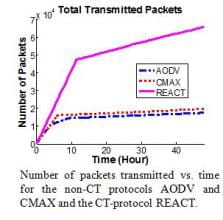CT Energy Balancing Improves Throughput of Energy Harvesting WSNs
The same mechanism that avoids the energy hole in battery-driven networks can be used to match energy consumption to energy production in energy harvesting nodes, leading to throughput improvements. Some preliminary results are shown in Figure for an 80-node network, assuming supercapacitor (SC)-only energy storage, each node starts with the same small amount of energy (1 J), and a harvesting rate of 40 mJ/min on average (to simulate pulses of vibration energy, such as from cars on a bridge). The initial slopes of the curves (i.e. the rates of transmission) correspond to when the nodes have excess stored energy. After about 10 hours, however, the rate of packet transmission becomes energy limited, as the SC voltage sometimes drops below the level that can sustain node operation. At any time, the CT-based REACT protocol has a higher packet transmission rate, compared to the non-CT protocols AODV and CMAX. In the energy-limited regime, the REACT rate is seven times the other rates.
nodes, leading to throughput improvements. Some preliminary results are shown in Figure for an 80-node network, assuming supercapacitor (SC)-only energy storage, each node starts with the same small amount of energy (1 J), and a harvesting rate of 40 mJ/min on average (to simulate pulses of vibration energy, such as from cars on a bridge). The initial slopes of the curves (i.e. the rates of transmission) correspond to when the nodes have excess stored energy. After about 10 hours, however, the rate of packet transmission becomes energy limited, as the SC voltage sometimes drops below the level that can sustain node operation. At any time, the CT-based REACT protocol has a higher packet transmission rate, compared to the non-CT protocols AODV and CMAX. In the energy-limited regime, the REACT rate is seven times the other rates.
Last revised on Jan,28,2010..

